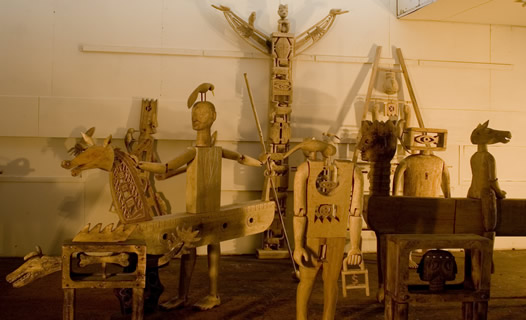SCULPTURE

Adam Rish has been making wooden sculpture in Bali since 2007, with local sculptor I Wayan Sumantra. Rish designs the pieces as scale drawings in three dimensions, drawn with a 2B pencil and ruler, mostly on location in Bali. He discusses the production process with Wayan and goes out to select the wood. The works are produced by Wayan in Ubud at his studio and then shipped to Sydney where Rish does the final detailing and polishing and waxing. Occasionally he may carve new details or pieces for the sculptures. The sculptures have been made into modular pieces so the slot together with pins for ease of transport and storage. For more stability they may be glued into place. Also screws through the feet into the floor will support them. They may be left outside as in the case of traditional sculpture and the artist likes the idea of them changing and graying with the elements. They are however made of soft wood so make break down if left exposed for more than 10 years. The pieces are made in an edition of 5 but as they are handmade, without power tools, considerable variation may occur in final form. A delay of 3-6 months on order may be expected although an extra charge for air freight may speed this up.
Adam Rish - Ethnographica: Michael Nagy Gallery 2007
On show are life-size wooden sculptures made in collaboration with I Wayan Sumantra in Ubud, Bali . The title “Ethnographica” has been chosen to challenge the term’s implied ethnocentricism (ie that art is made by Western culture whereas indigenous cultures make exotic curios). While Rish’s work revels in both exotic and graphic elements, in fact these forms are not exotic to the tribal societies from which they come but integral to their collective consciousness and draw spiritual and thus visual authority from this certainty of meaning.
The exhibition is based upon traditional carving from Southeast Asia and more specifically tau-tau spirit figures from Sulawesi and horse sculptures from West Timor and Sumba (where Rish has worked making ikat). Rish has transformed these forms with his contemporary domestic iconography, thus: In “My Kingdom for a Horse” the horse rides backwards on the back of a blind king. “Noah” has only a climate change desert to walk his boat over. “Totem”, an Asmat house pole, stacks cars, phones, houses, soldiers and winged AK47’s beneath a little king. “Metamorphosis” has a Kafka cockroach writing a book out of his hand. “Vanity Eunuch” is a glass coffee table supported by a kneeling Narcissus staring into a palette shaped mirror with a carrot in his rectum. Rather than a plea to ‘eat right’ Rish claims this as a triumph of form over function! “Bidadari Jatuh/Fallen Angel” has a dunce capped angel in the corner on his mobile phone. “Andung” is based upon a traditional skull tree from Sumba, whereby ones vanquished enemies’ skulls are turned into decoration to rob them of their power.
Also included in the show are the original sculpture designs transferred to Tongan tapa cloth. Rish likes the idea of a traditional “paperless society” using papyrus to design monolithic works.
Traditionally tau-tau sculptures were used in ceremonial burials to represent the deceased in the after-life. Rish doubts many of his collectors will be using them for this but, in our super-functional society, is sure they will make very fine, garden furniture.
IMAGES HOME BIOGRAPHY NEXT EXHIBITION